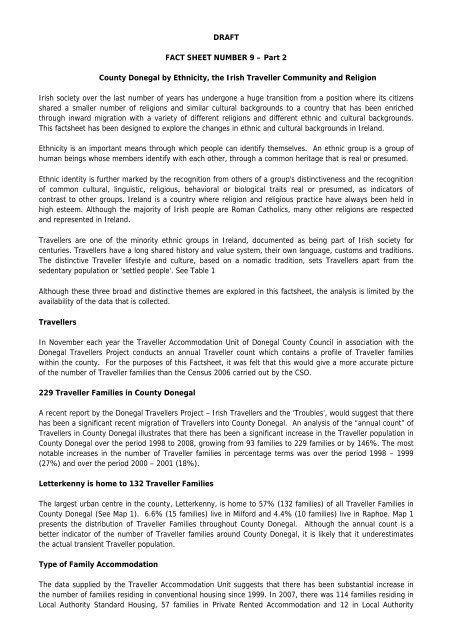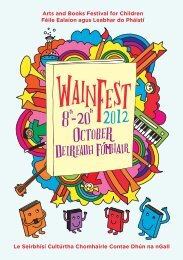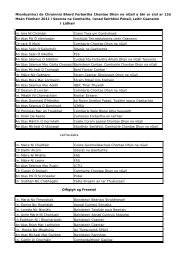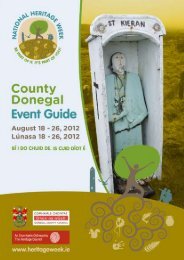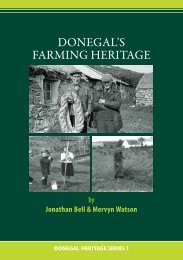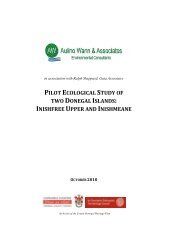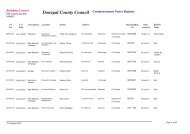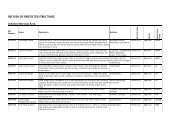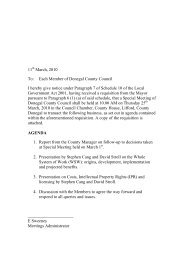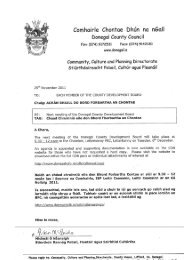Level 1 Actions Part B: Level 3 Actions - Donegal County Council
Level 1 Actions Part B: Level 3 Actions - Donegal County Council
Level 1 Actions Part B: Level 3 Actions - Donegal County Council
Create successful ePaper yourself
Turn your PDF publications into a flip-book with our unique Google optimized e-Paper software.
DRAFT<br />
FACT SHEET NUMBER 9 – <strong>Part</strong> 2<br />
<strong>County</strong> <strong>Donegal</strong> by Ethnicity, the Irish Traveller Community and Religion<br />
Irish society over the last number of years has undergone a huge transition from a position where its citizens<br />
shared a smaller number of religions and similar cultural backgrounds to a country that has been enriched<br />
through inward migration with a variety of different religions and different ethnic and cultural backgrounds.<br />
This factsheet has been designed to explore the changes in ethnic and cultural backgrounds in Ireland.<br />
Ethnicity is an important means through which people can identify themselves. An ethnic group is a group of<br />
human beings whose members identify with each other, through a common heritage that is real or presumed.<br />
Ethnic identity is further marked by the recognition from others of a group's distinctiveness and the recognition<br />
of common cultural, linguistic, religious, behavioral or biological traits real or presumed, as indicators of<br />
contrast to other groups. Ireland is a country where religion and religious practice have always been held in<br />
high esteem. Although the majority of Irish people are Roman Catholics, many other religions are respected<br />
and represented in Ireland.<br />
Travellers are one of the minority ethnic groups in Ireland, documented as being part of Irish society for<br />
centuries. Travellers have a long shared history and value system, their own language, customs and traditions.<br />
The distinctive Traveller lifestyle and culture, based on a nomadic tradition, sets Travellers apart from the<br />
sedentary population or 'settled people'. See Table 1<br />
Although these three broad and distinctive themes are explored in this factsheet, the analysis is limited by the<br />
availability of the data that is collected.<br />
Travellers<br />
In November each year the Traveller Accommodation Unit of <strong>Donegal</strong> <strong>County</strong> <strong>Council</strong> in association with the<br />
<strong>Donegal</strong> Travellers Project conducts an annual Traveller count which contains a profile of Traveller families<br />
within the county. For the purposes of this Factsheet, it was felt that this would give a more accurate picture<br />
of the number of Traveller families than the Census 2006 carried out by the CSO.<br />
229 Traveller Families in <strong>County</strong> <strong>Donegal</strong><br />
A recent report by the <strong>Donegal</strong> Travellers Project – Irish Travellers and the ‘Troubles’, would suggest that there<br />
has been a significant recent migration of Travellers into <strong>County</strong> <strong>Donegal</strong>. An analysis of the “annual count” of<br />
Travellers in <strong>County</strong> <strong>Donegal</strong> illustrates that there has been a significant increase in the Traveller population in<br />
<strong>County</strong> <strong>Donegal</strong> over the period 1998 to 2008, growing from 93 families to 229 families or by 146%. The most<br />
notable increases in the number of Traveller families in percentage terms was over the period 1998 – 1999<br />
(27%) and over the period 2000 – 2001 (18%).<br />
Letterkenny is home to 132 Traveller Families<br />
The largest urban centre in the county, Letterkenny, is home to 57% (132 families) of all Traveller Families in<br />
<strong>County</strong> <strong>Donegal</strong> (See Map 1). 6.6% (15 families) live in Milford and 4.4% (10 families) live in Raphoe. Map 1<br />
presents the distribution of Traveller Families throughout <strong>County</strong> <strong>Donegal</strong>. Although the annual count is a<br />
better indicator of the number of Traveller families around <strong>County</strong> <strong>Donegal</strong>, it is likely that it underestimates<br />
the actual transient Traveller population.<br />
Type of Family Accommodation<br />
The data supplied by the Traveller Accommodation Unit suggests that there has been substantial increase in<br />
the number of families residing in conventional housing since 1999. In 2007, there was 114 families residing in<br />
Local Authority Standard Housing, 57 families in Private Rented Accommodation and 12 in Local Authority


